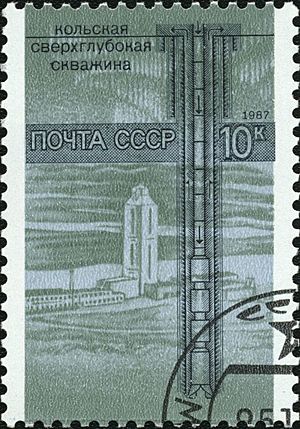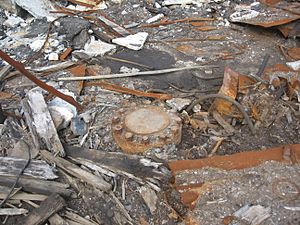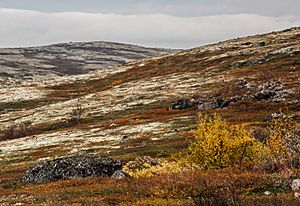Kola Superdeep Borehole facts for kids

Superstructure of the Kola Superdeep Borehole, 2007
|
|
| Location | |
|---|---|
| Location | Pechengsky District |
| Murmansk Oblast | |
| Country | Russia |
| Coordinates | 69°23′47″N 30°36′36″E / 69.3965°N 30.6100°E |
| Greatest depth | 12,262 metres (40,230 ft; 7.619 mi) |
| History | |
| Opened | 1965 |
| Active |
|
| Closed | 1995 |
The Kola Superdeep Borehole is a very deep hole drilled into the Earth's crust by the Soviet Union. It is located in the Pechengsky District on the Kola Peninsula in Russia. The main goal was to drill as deep as possible to learn more about our planet.
Drilling started on May 24, 1970. The deepest part of the project, called SG-3, reached an amazing depth of 12,262 metres (40,230 ft; 7.619 mi) in 1989. This made it the deepest artificial point on Earth at the time.
The project stopped in 1995 because the Soviet Union broke apart. The site is now abandoned, but many curious people still visit its ruins.
| Top - 0-9 A B C D E F G H I J K L M N O P Q R S T U V W X Y Z |
Drilling Deep: How Far Did They Go?

Scientists hoped to drill down to 15,000 m (49,000 ft). On June 6, 1979, the Kola borehole broke the world depth record. The previous record was held by the Bertha Rogers hole in Oklahoma, United States, which was 9,583 m (31,440 ft) deep.
By 1983, the drill had passed 12,000 m (39,000 ft). Drilling was paused for about a year so that scientists and important visitors could come to see the site.
The hole reached 12,262 m (40,230 ft) in 1989. At that time, they expected to reach 13,500 m (44,300 ft) by 1990 and 15,000 m (49,000 ft) by 1993. However, the temperature deep inside the Earth was much hotter than expected. It was 180 °C (356 °F) instead of the expected 100 °C (212 °F). Because of this extreme heat, drilling deeper became too difficult. So, the project was stopped in 1992.
Discoveries from the Deep
The Kola borehole went through about one-third of the Baltic Shield, which is a part of the continental crust. This crust is thought to be about 35 kilometres (22 mi) deep. The project helped scientists learn a lot about the Earth's geology.
One surprising discovery was tiny plankton fossils found 6 kilometres (3.7 mi) below the surface. Another unexpected find was a huge amount of hydrogen gas. The liquid that came out of the hole was described as "boiling" with hydrogen.
Other Deep Drilling Projects
The Kola Superdeep Borehole was not the only project trying to drill deep into the Earth.
- The United States started a similar project in 1957 called Project Mohole. This project aimed to drill through the shallow crust under the Pacific Ocean near Mexico. However, it was stopped in 1966 because it ran out of money. This program later inspired successful ocean drilling projects around the world.
- Germany also drilled a superdeep borehole called KTB (German Continental Deep Drilling Programme) from 1987 to 1995. It reached a depth of 9,101 m (29,859 ft). The temperatures there were more than 260 °C (500 °F). Special tools were developed to measure things in these very hot conditions.
World Records for Deep Holes
For almost 20 years, the Kola Superdeep Borehole was the longest and deepest borehole in the world. However, new drilling methods have created even longer holes.
- In May 2008, a new record for borehole length was set by the BD-04A well. This well was drilled by Transocean for Maersk Oil in Qatar. It reached a total length of 12,289 m (40,318 ft) and stretched 10,902 m (35,768 ft) horizontally.
- On January 28, 2011, Exxon Neftegas Ltd. drilled an even longer well off the coast of Sakhalin island in Russia. This well, called Odoptu OP-11, reached a total length of 12,345 m (40,502 ft).
- Then, on August 27, 2012, Exxon Neftegas Ltd. broke its own record with the Z-44 Chayvo well. This well reached a total length of 12,376 metres (40,604 ft).
Even with these new longer wells, the Kola Superdeep Borehole (SG-3) still holds the world record for being the deepest artificial point on Earth, reaching 12,262 metres (40,230 ft) straight down.
Related pages
See also
 In Spanish: Pozo superprofundo de Kola para niños
In Spanish: Pozo superprofundo de Kola para niños





